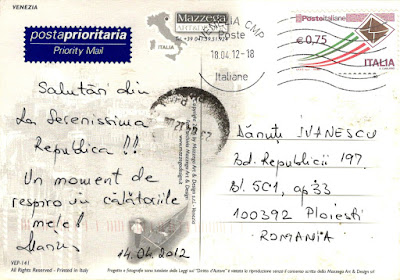 |
| 2487 Venice: A bridge Over A Small Canal; Rialto Bridge; Bridge of Sighs; St Mark's Square; St Mark's Basilica |
Spread over 118 small islands, separated by canals and linked by bridges, in the marshy Venetian Lagoon which stretches along the shoreline, between the mouths of the Po and the Piave Rivers, Venice was a major maritime power during the Middle Ages and Renaissance, and a staging area for the Crusades and the Battle of Lepanto, as well as a very important center of commerce (especially silk, grain, and spice) and art in the 13th century up to the end of the 17th century. This made Venice a wealthy city throughout most of its history.
In this lagoon, nature and history have been closely linked since the 5th century when Venetian populations, to escape barbarian raids, found refuge on the sandy islands of Torcello, Jesolo and Malamocco. Over the centuries, during the entire period of the expansion of Venice, when it was obliged to defend its trading markets against the commercial undertakings of the Arabs, the Genoese and the Ottoman Turks, Venice never ceased to consolidate its position in the lagoon.
The whole city is an extraordinary architectural masterpiece in which even the smallest building contains works by some of the world's greatest artists such as Giorgione, Titian, Tintoretto, Veronese and others. From Torcello to the north to Chioggia to the south, almost every small island had its own settlement, town, fishing village and artisan village. However, at the heart of the lagoon, Venice itself stood as one of the greatest capitals in the medieval world.
The influence of Venice on the development of architecture and monumental arts is considerable; first through the Serenissima's fondachi or trading stations, along the Dalmatian coast, in Asia Minor and in Egypt, in the islands of the Ionian Sea, the Peloponnesus, Crete, and Cyprus, where the monuments were clearly built following Venetian models. But when it began to lose its power over the seas, Venice exerted its influence in a very different manner, thanks to its great painters.
Venice has a rich and diverse architectural style, the most famous of which is the Venetian Gothic style, which combined use of the Gothic lancet arch with Byzantine and Ottoman influences. It originated in 14th-century Venice, where the confluence of Byzantine style from Constantinople met Arab influence from Moorish Spain. Chief examples of the style are the Doge's Palace and the Ca' d'Oro in the city. The city also has several Renaissance and Baroque buildings, including the Ca' Pesaro and the Ca' Rezzonico.
In 1987 Venice and its Lagoon was designated an UNESCO World Heritage Site. Among the famous landmarks of the city present on the postcards which make up my collection are:
• St Mark's Square
• St Mark's Basilica
• Rialto Bridge
• Burano
• Venetian Arsenal
• National Library of St Mark's
About the stamp
The stamp belongs to a series of definitive stamps, about which I wrote here.
References
Venice - Wikipedia
Venice and its Lagoon - UNESCO official website
Sender: Marius Vasilescu
Sent from Venice (Veneto / Italy) on 18.04.2012

No comments:
Post a Comment